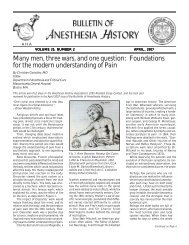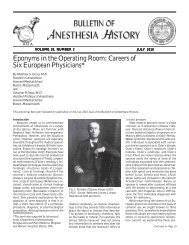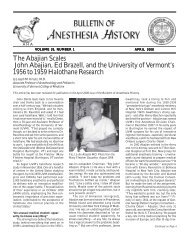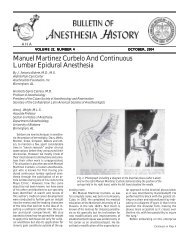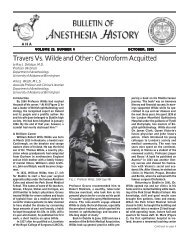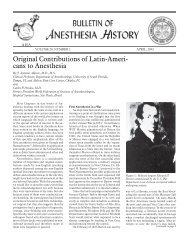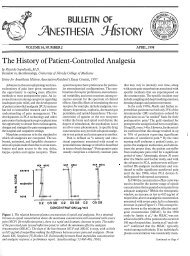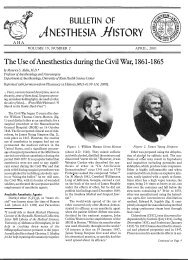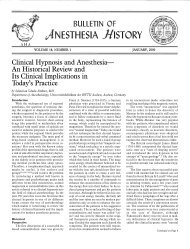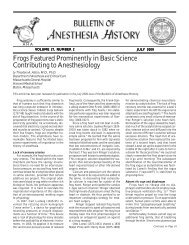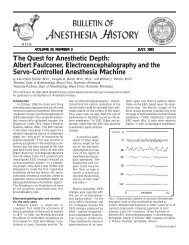January 2006, Vol 24 - Anesthesia History Association
January 2006, Vol 24 - Anesthesia History Association
January 2006, Vol 24 - Anesthesia History Association
You also want an ePaper? Increase the reach of your titles
YUMPU automatically turns print PDFs into web optimized ePapers that Google loves.
BULLETIN OF ANESTHESIA HISTORY 7<br />
the Latin medical literature but it also has<br />
other Latin equivalents: “emotio mortis”<br />
(death-like mental status) or “vigilans sopor”<br />
(alive sleep). We would call it in German<br />
“state of insensitivity” or “dullness”<br />
although in German dullness is used to<br />
describe a stupid person.<br />
It is also called stupor or deep sleep but<br />
in stupor tactile sensations and their responses<br />
to tactile stimuli are preserved.<br />
The seat of all sensations is the mind/<br />
soul. Sensations are brought to it by the<br />
organs of the senses of the body; from the<br />
mind/soul, flow responses to stimuli as<br />
body reactions in the normal person. Thus<br />
mind/soul receives and produces (emits).<br />
<strong>Anesthesia</strong> may be caused by body damage<br />
but later the body returns to normal<br />
while the anesthesia (i.e., disease of the<br />
mind/soul) persists.<br />
If congenital, anesthesia is impossible<br />
to cure; if acquired, still difficult to cure<br />
but some physical remedies can be tried,<br />
though not effectively if anesthesia is very<br />
deep. If slight and transient, those remedies<br />
may be helpful, though not well<br />
proven: vesicants, compresses, emetics, inhalation<br />
spirits, rubbing skin dry or with<br />
alcohol or various other products.<br />
In his work Quistorp cites a number of<br />
authorities for various statements. Sometimes<br />
he gives a name and publication;<br />
other citations are just the name of the<br />
authority. The authorities cited and their<br />
locations in the text are listed in the table<br />
below just as Quistorp has cited them. In<br />
addition to these authorities, Quistorp also<br />
cites various Greek and Roman authors<br />
such as Hippocrates, Pliny, Galen, and<br />
Seneca as well as St. Augustine and various<br />
Biblical passages. Further investigation<br />
of the sources listed in this table may<br />
offer clues as to just what happened to the<br />
concept of “anaesthesia” between the ancient<br />
Greeks and Romans and Quistorp’s<br />
consolidation of current knowledge. (Table<br />
I)<br />
The translator [RJD] has a number of<br />
comments about Quistorp’s work:<br />
1. The text is awkward. I’ve tried to<br />
do a literal translation so as to keep<br />
the author’s meaning.<br />
2. Quistorp uses the word ANIMA<br />
all the time; in Latin this means<br />
mind, soul, vital center, breath. In<br />
the text here, it seems to me that he<br />
uses it as soul, mind, and occasionally<br />
brain. Readers will have<br />
to use one of the three meanings<br />
according to the context.<br />
Table I<br />
3. He suggests that the word anaesthesia<br />
was already used by the<br />
Greeks and Romans. The word is<br />
not in common Latin dictionaries<br />
I used, but I did not check the big<br />
ones like Cassell. This Greek origin<br />
is quoted in Osler’s papers in<br />
1918 (see TE Keyes). Thus<br />
Quistorp would not be the first one<br />
to have used the word.<br />
4. His use of the word ANAESTHE-<br />
SIA is complex. Here is my interpretation:<br />
a) He starts with the literal<br />
Greek meaning; absence of<br />
sensations as caused by sensory<br />
stimuli (light, sounds,<br />
pain, etc.). This is very<br />
much what we call general<br />
anesthesia in our practice.<br />
Continued on page 8



